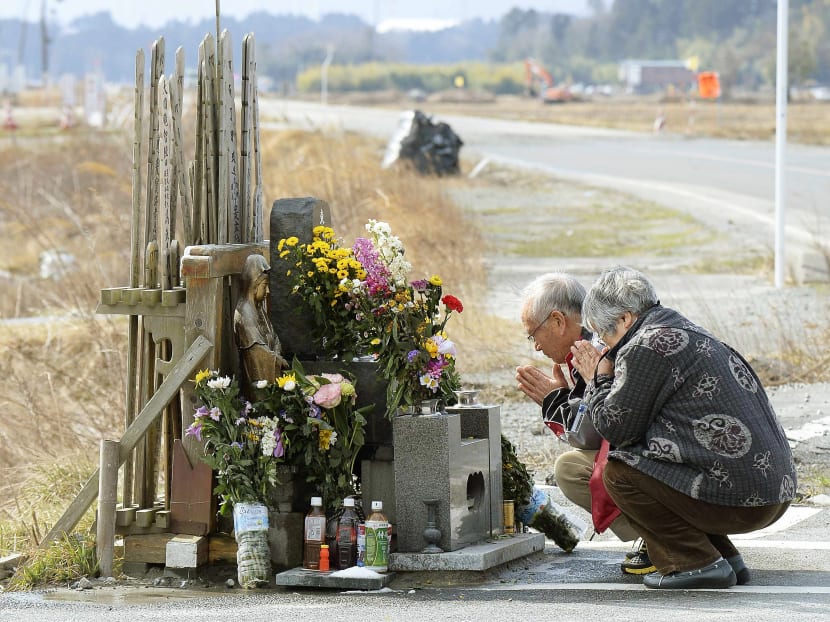Residents who fled Fukushima meltdown fear return to ghost town
TOKYO — Weed-engulfed buildings and shuttered businesses paint an eerie picture of a coastal Japanese town abandoned after a monstrous earthquake and tsunami triggered meltdowns in the Fukushima nuclear plant.

People pray for victims of the March 11, 2011 earthquake and tsunami near Tokyo Electric Power Company's (TEPCO) tsunami-crippled Fukushima Daiichi nuclear power plant in this photo taken on March 11, 2015. Photo: Reuters/Kyodo
TOKYO — Weed-engulfed buildings and shuttered businesses paint an eerie picture of a coastal Japanese town abandoned after a monstrous earthquake and tsunami triggered meltdowns in the Fukushima nuclear plant.
Namie, one of the communities hardest hit by the 2011 disaster, had 21,000 residents before they fled radiation spewing from the reactors 8km away. Prime Minister Shinzo Abe is now looking to repopulate the town as early as next year, a symbolic step toward recovery that might also help soften opposition to his government’s plan to restart Japan’s mostly mothballed nuclear industry.
“The national and local governments are trying to send us back,” said Mr Yasuo Fujita, 64, a sushi chef who lives alongside hundreds of other Fukushima evacuees in a modern high rise in Tokyo more than 200km away. “We do want to return — we were born and raised there. But can we make a living? Can we live next to the radioactive waste?”
So far few evacuees are making plans to go back even as clean-up costs top US$30 billion (S$41.8 billion) and Abe’s government restores infrastructure. That reluctance mirrors a national scepticism toward nuclear power that threatens to erode the prime minister’s positive approval ratings, particularly in areas with atomic reactors.
MOTHBALLED REACTORS
Officials in his government are calling for nuclear power to account for as much as 22 per cent of Japan’s electricity supply by 2030, nearly the same percentage as before the Fukushima meltdown, in part to help meet climate goals. Only two of the nation’s 42 operable nuclear plants are currently running, leaving the country even more heavily reliant on imports of oil and gas.
A poll published by the Asahi newspaper this week found 57 per cent of respondents were opposed to restarting nuclear reactors, compared with 29 per cent in favour. One of Mr Abe’s ministers lost his seat in Fukushima in an upper house election in July, and the government suffered another setback when an anti-nuclear candidate won Sunday’s election (Oct 16) for governor of Niigata prefecture, home to the world’s largest nuclear plant.
Some 726sqkm — roughly the size of New York City — of Fukushima prefecture remain under evacuation orders, divided by level of radioactivity. While the government is looking to reopen part of Namie next year, most of the town is designated as “difficult to return to” and won’t be ready for people to move back until at least 2022.
“We must make the area attractive, so that people want to return there,” Reconstruction Minister Masahiro Imamura said this week. “I want to do everything I can to make it easy to go back.”
Workers are cleaning by scraping up soil, moss and leaves from contaminated surfaces and sealing them in containers. Still, the operation has skipped most of the prefecture’s hilly areas, leading to fears that rain will simply wash more contamination down into residential zones. Decommissioning of the stricken plant itself is set to take as many as 40 years.
The bill for cleaning up the environment is ballooning, with the government estimating the cost through March 2018 at ¥3.3 trillion (S$44.2 billion). That’s weighing on Tokyo Electric Power Co Holdings, which is already struggling to avoid default over decommissioning costs.
“They are spending money in the name of returning things to how they were” without having had a proper debate on whether this is actually possible, said Mr Yutaka Okada, senior researcher at Mizuho Research Institute in Tokyo. “Was it really right to spend this enormous amount of money?”
Namie officials, operating from temporary premises 100km away in the city of Nihonmatsu, are plowing ahead with preparations. A middle school in the town is scheduled for remodelling to add facilities for elementary pupils — even though they expect only about 20 children to attend. Similar efforts in nearby communities have had limited success.
Only 18 per cent of former Namie residents surveyed by the government last year said they wanted to return, compared with 48 per cent who did not. The remainder were undecided.
STAYING PUT
Mr Fujita, the sushi chef, has joined the ranks of those starting afresh elsewhere. He opened a seafood restaurant near his temporary home last year, and is buying an apartment in the area. In a sign the move will be permanent, he even plans to squeeze the Buddhist altar commemorating his Fukushima ancestors into his Tokyo home.
For those that do return, finding work will be a headache in a town that was heavily dependent on the plant for jobs and money.
Ms Haruka Hoshi, 27, was working inside the nuclear facility when the earthquake struck, and she fled with just her handbag. Months later she married another former employee at the plant, and they built a house down the coast in the city of Iwaki, where they live with their three-year-old son. They have no plans to return.
“It would be difficult to recreate the life we had before,” she said. “The government wants to show it’s achieved something, to say: ‘Fukushima’s all right, there was a terrible incident, but people are able to return after five years.’ That goal doesn’t correspond with the reality.” BLOOMBERG






